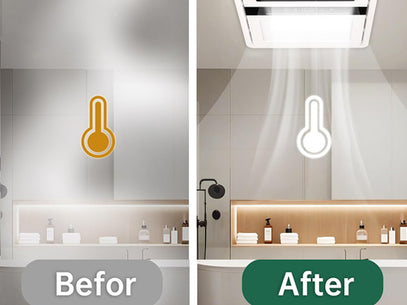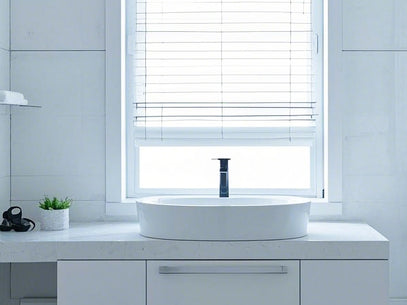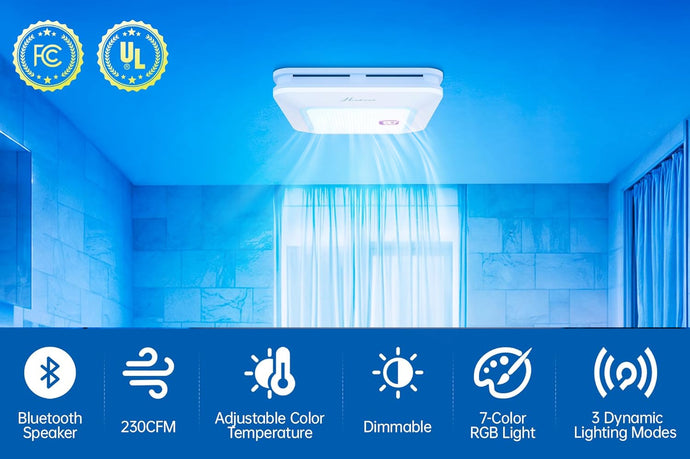
How to Choose the Right Bathroom Exhaust Fan?
Improve Ventilation, Control Moisture, and Enhance Air Quality
- A bathroom exhaust fan, often called a bath fan, is essential for maintaining healthy indoor air quality.
- But its benefits extend beyond just the bathroom—it’s a powerful tool for home ventilation, helping to reduce humidity, odors, and airborne pollutants in various spaces like laundry rooms, closets, mudrooms, and home gyms.
- If you're looking to replace an old exhaust fan, install a new unit, or upgrade to a high-efficiency model, this comprehensive guide will walk you through everything you need to know.
- From selecting the right CFM rating to exploring modern features like quiet operation, Bluetooth connectivity, we’ll help you make the best choice for improving air circulation and moisture control in your home.
Please focus on the following key points.

Improved Air Quality

Moisture Control

Odor Removal

Ventilation

Health & Comfort
How to Choose the Right Exhaust Fan?
How do I determine the right CFM rating for my bathroom exhaust fan?
First things first, let's determine the right size for your fan. Our experts suggest that your bath fan should be able to remove the entire volume of air in the room eight times per hour. To figure out how many Cubic Feet per Minute (CFM) your bathroom needs, follow these simple steps:
- Measure your bathroom's length, width, and height. For example, let's say your bathroom measures 10 feet wide by 6 feet long and has a ceiling height of 10 feet. Multiply these numbers together (6 x 10 x 10), and you get a total cubic footage 600.
- Divide the cubic footage of your bathroom by 60 minutes per hour to determine the CFM rating needed for one air exchange per hour. In our example, 600 cubic feet divided by 60 minutes per hour equals 10 CFM for one exchange. So far, so good!
- Considering the recommended eight air changes per hour, multiply the CFM per hour by eight. In our example, 10 CFM x 8 exchanges equal an 80 CFM rating. Voila! At the very least, your bath fan should be able to move 80 CFM to remove indoor air pollutants effectively.
Remember, you can always choose a fan with more CFMs than your room needs for extra oomph!
How do I choose between room-side and attic installation?
If you are installing a new fan in open construction (no drywall is present) you can easily install the fan wherever it is needed.
When replacing an existing bathroom exhaust fan, carefully measure the opening in your ceiling or wall. In some cases you may be able to replace your existing fan with one that is the same size. If you are upgrading or replacing with a larger model, you may have to cut some of the drywall to ensure a proper fit. Be sure to measure the height as well. Some newer models are taller than older models.
Some models offer Room Side installation. This means you do not have to access the unit from the attic in order to replace it.
What factors affect choosing the right duct size?
Proper ducting is essential for efficient and effective exhaust ventilation. The ducting size plays a significant role in maintaining optimal airflow and reducing noise. Consider the following points when determining the ducting size for your exhaust ventilation system:Sizing Guidelines: Choose ducting size based on the capacity of your fan and the distance the air needs to travel. Too small ducting can restrict airflow, reducing the system's efficiency. Generally, larger ducts are better for minimizing air resistance and noise.Fan Capacity: Match the ducting size to the fan's capacity. Larger fans might require bigger ducts to accommodate the increased airflow.Duct Length and Turns: Longer duct runs, and multiple turns can increase air resistance. If your installation requires lengthy ducting, consider upsizing the duct to compensate for the potential loss of airflow.Noise Reduction: Properly sized ducting can help reduce noise generated by the exhaust fan. Using larger ducts and keeping the airflow velocity within recommended limits can contribute to quieter operation.
What does the sone rating mean for exhaust fan noise levels?
Sones are used to quantify how loud a sound is perceived by the human ear. When it comes to exhaust fans, a lower sone rating indicates quieter operation.
Less than 1 sone Whispers
1 sone- Refrigerator Noise
2 sones- Calm Office
3 sones- Normal Conversation
4 sones- TV/Radio
5 sones- Busy Restaurant
6 sones- Sporting Event
How do I choose the right lighting for my exhaust fan?
Integrating lighting with your exhaust ventilation system can enhance both functionality and aesthetics. Here's what to consider when selecting the lighting type:
- LED Lighting: Energy-efficient and long-lasting, LED lighting is an excellent choice for exhaust ventilation systems. It provides bright illumination while consuming less energy than traditional incandescent or fluorescent lights.
- Warm vs. Cool Light: Decide on the color temperature of the lighting based on the ambiance you want to create. Warm light (around 2700K-3000K) is more cozy and inviting, while cool light (around 4000K-5000K) is more suited for tasks and productivity.
- Dimmable Options: Consider exhaust ventilation systems that offer dimmable lighting options. This allows you to adjust the brightness according to your needs and mood.
If your fan sounds like a stadium cheering you on, it might be time for an upgrade. Let's upgrade the motor to make it sound like a soothing whisper.
Find a noise-reducing motor that matches your current model and brings tranquility back to your bathroom oasis. Let's see if we can find you the perfect match!

Combines ventilation, lighting, and audio in one unit for a seamless experience. Functions operate independently or together, reducing the need for multiple devices. Saves space while enhancing comfort and functionality in the bathroom.











































































































































